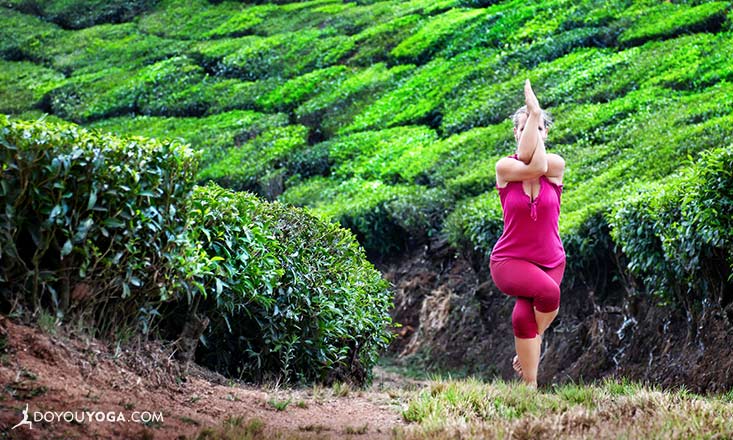We all have one — a nemesis posture that we just can’t ‘nail’. Only…are we supposed to nail yoga? I don’t think so.
Mine is Eagle (Garudasana). I feel like fighting it every time I do it, but it is not in the yoga spirit to battle a posture, to seek to conquer an asana, let alone to set out to master a practice.
Yoga calls for making peace, and perhaps that’s what yoga ‘mastery’ really is – the ultimate acceptance that if yoga is always the teacher and you are always the student then you can never be yoga’s master, let alone a conqueror. Surrender really is the only answer.
So how do you deal with that ‘nemesis’ posture constantly challenges you? (If you have two or three postures that you argue a lot with, focus on the first one that springs to mind). Here are some tips on how to improve in your practice.
1. Don’t Avoid
It’s easy to make excuses, to decide that you need to just relax in child’s pose or Savasana, that you are too tired. If you must rest (and that’s perfectly OK in a yoga practice), pick another posture to take a break in rather than avoiding the asana you find most challenging. Get through your challenge posture with focus and willpower, then relax.
2. Don’t Argue
There are any number of reasons why you might find a posture challenging – don’t say ‘it’s too hard because my hips aren’t open enough’, or argue that you just have to modify because your wrists aren’t strong enough or your ankle is weak (never do anything to compromise an injury but don’t make excuses either).
For me, in Eagle posture, I can never get the palms of my hands to quite come together, although I’m working on it and am now able to grip the bottom of my top palm with the fingers of my lower palm as I cross my arms at the elbows.
But it is the leg wrapping in eagle that does my head in. Adduction is really hard for me. I’m getting there with wrapping my right leg over my left and hooking the foot in behind my calf, but wrapping my left leg is a lot more challenging. So I have to accept, rather than argue with this imbalance.
3. Breathe
It goes without saying that a focus on breath is always going to improve a posture. With a particularly challenging asana, try a focused breath – inhale and mentally accept the challenge of the posture and the lessons it has to teach you, and then exhale letting go of any resistance and attachment to ‘mastery’ of the asana.
You might script an affirmation in your mind: “I acknowledge how this posture is difficult for me and how it is teaching me patience and I let go of my fear of pain and fear of failure in the posture.”
4. Celebrate Subtle Changes and Small Wins
Even though challenging postures can really rest you, they can also offer up small ’victories’. You may have to be patient for a major breakthrough, but if you are really aware of the subtleties, you may notice some aspect of the posture is easier – be it focus, balance, a subtle lengthening, a squaring of shoulders or hips or whatever.
5. Make Friends
Ultimately beyond ceasing the avoidance and arguments, you need to come into an acceptance that the postures that challenge you the most are the yoga asanas you need to practice the most.
The yoga that will transform your life is the yoga you find the most difficult.~Kathy Kruger
Thank that nemesis posture for doing you good, for being your friend, and welcome the important part it plays in your yoga journey. One day, through an approach of surrender, you are going to smile to yourself as that nemesis posture becomes a firm favourite.
My ego might be prey to the Eagle posture right now, I can see myself perched up on a rock like an Eagle one day soon, smiling (a little proudly) to myself.


